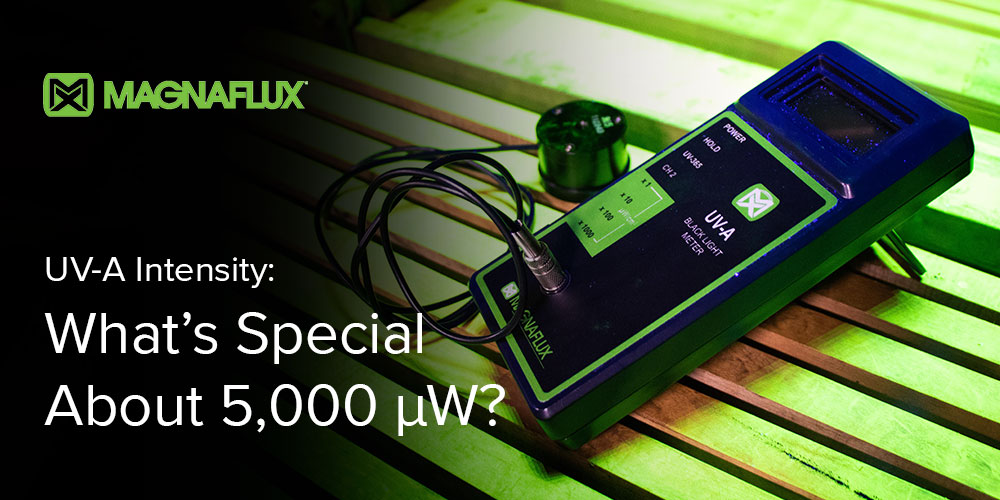By David Geis, Product Manager

Light intensity follows an inverse-square law. Say there’s a bright lamp that’s one meter away from you. If you move out to 2 meters, the light from the lamp won’t be half as bright, it’ll be one quarter as bright. Going farther out to 3 meters drops it down to 1/9th the original intensity. It works the same way as you move closer too. The same lamp will be 4 times as bright 50 cm away, and 16 times as bright at only 25 cm. What this means for us is that the distance to the lamp is just as important as the amount of light it puts out.
To compare the intensity of UV-A lamps in fluorescent inspection, our industry has set a standard distance of 15 in / 38 cm as a benchmark. Using a standard distance, the relative performance of different lamps can be compared directly.
UV-A irradiance is required to make penetrant and magnetic particle materials fluoresce (that’s what makes them visible). The more UV-A available, the brighter the fluorescence will be. But there are limits. ASTM E2297 and E1316 define UV-A light as wavelengths between 320-400 nm and define visible light as wavelengths between 400-760 nm. But in nature, the light spectrum is continuous. There is no natural difference between what we call UV-A and what we call visible light – those are artificial divisions. Human vision, in the same way, is continuous. There’s no hard-line cutoff of what the eye can perceive, and light perception changes as we age. Younger eyes can perceive light down to 390 nm (even though we technically define that as UV-A), and if there is no other light source, even shorter wavelengths down to 380 nm can be seen as deep violet light.
In the dark environment of an inspection booth, human vision can perceive some UV-A light. Even though fluorescence increases with increasing UV-A, there are diminishing returns as far as what you can see. Too much UV-A can overpower a fluorescent indication – this is commonly called “veiling glare”.
Studies on the effect of UV-A intensity on fluorescence have demonstrated that the dyes and pigments used in penetrants and magnetic particle materials can degrade with long exposure to very intense irradiation. Exposure to high levels of UV-A over time will decrease the amount of fluorescent light produced. This effect is commonly described as “fluorescent fade”.
To guard against both veiling glare and fluorescent fade, maximum UV-A intensities have been established. The details vary with industry standard, OEM, Prime, and application. Many authorities permit UV-A intensities up to 10,000 µW/cm2, but exposure time must be limited to prevent fluorescent fade. The maximum intensity of 5,000 µW/cm2 according to ISO 3059 is commonly accepted as safe for extended exposures.
We have a standard distance of 15 in / 38 cm thanks to the way that light works. And we have a maximum intensity of 5,000 µW/cm2 thanks to how human vision and fluorescence work. It’s easy to use those two figures together: 5,000 µW/cm2 at 15 in / 38 cm. With so many different light sources available, that combination doesn’t work in all cases.
The concerns leading to maximum intensity are about the intensity at the examination surface regardless of lamp distance. While a hand-held lamp may be commonly used at the standard 15 in / 38 cm distance, a torch or flashlight will be used much closer. And overhead stationary light fixtures are used at much greater distances than standard. In all cases, the UV-A intensity at the examination surface needs to be controlled. A torch that delivers 5,000 µW/cm2 at a distance of 5 in / 13 cm is very useful for close examination of bores and tight spaces. But at the standard 15 in / 38 cm, the intensity would be less than 560 µW/cm2. In the same way, an overhead lamp fixture delivering 5,000 µW/cm2 while mounted 2.5 ft / 0.76 m above the inspection surface would be nearly 10,000 µW/cm2 at the standard distance.
In these examples, the torch and the overhead fixture have widely different intensities at the standard distance. But when they are used as designed and intended, they are perfectly acceptable. That’s because ISO 3059 and other standards set the maximum intensity limit of 5,000 µW/cm2 at the examination surface, not at a standard distance of 15 in / 38 cm.
The ST700 was designed to meet inspection lamp specifications while maximizing the area available to perform examinations. The ST700 is a stationary lamp fixture intended to be mounted at a distance from examination surfaces, giving the inspector ample room to work. To deliver enough UV-A to perform examinations while mounted up to 36 in / 0.9 m away, the ST700 is set for 7,000 µW/cm2 at the standard distance of 15 in / 38 cm. When working to Rolls-Royce and Airbus specs, that translates to a minimum working distance of 24 in / 61 cm.
Published August 14, 2018
JOIN OUR MAILING LIST TO RECEIVE THE LATEST NDT INSIGHTS AND ARTICLES FROM MAGNAFLUX
JOIN OUR MAILING LIST TO RECEIVE THE LATEST NDT INSIGHTS AND ARTICLES FROM MAGNAFLUX
155 Harlem Avenue
Glenview, IL 60025, USA
Telephone: +1 847-657-5300
Contact Magnaflux Customer Service